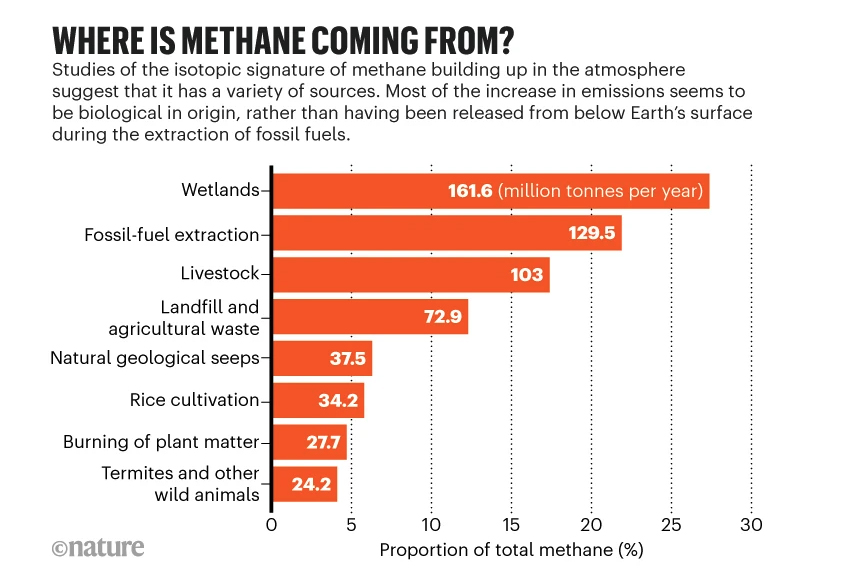SCIENTISTS are raising alarm over “dangerously fast” growth in atmospheric methane, as concentrations soar past 1,900 parts per billion.
In a new article in the science journal Nature, researchers say that they fear that global warming itself is behind the rapid rise. As wetlands dry out, in part driven by rising global temperatures, they release the methane they once stored into the atmosphere.
However, fossil fuels are also an important source of methane emissions. In an editorial in 2021, Nature noted that methane emissions from natural gas are a key component in the sharp rise in methane emissions. As a relatively clean source of fossil energy, the use of natural gas has soared by more than 50% over the past two decades. Partly as a result of this, atmospheric methane concentrations have more than doubled since pre-industrial times, from around 700 parts per billion by volume to nearly 1,900 ppb in 2020.
Referencing the new Nature article in Nature, Hannah Ritchie from Our World in Data posted a graphic on Twitter (now X) (below). The graphic shows key sources of methane emissions. Wetlands and fossil fuel extraction are the most significant sources, with livestock a close third.
Nature also points the finger at livestock methane emissions, but notes that “Reducing methane from livestock represents a particular challenge. People could eat less meat, but persuading people to change their diet is rarely straightforward. Moreover, meat consumption is rising in low- and middle-income countries – in line with rising incomes. It should be easier to curb emissions from other sectors. In many cases, doing so wouldn’t cost anything – and it could even be profitable.”
Discussions around methane sources and their warming impacts are never simple, and a respected blogger, known as The Regenetarian, has taken issue with the raw data presented in Ritchie’s post.
He writes on Twitter/X that: “The tweet from Our World in Data illustrates the reductive, overly simplistic, widely promulgated understanding of the atmospheric chemistry of methane. Per this overly simplistic view, all methane is the same and cutting gross emissions of methane is all that matters.”
He says that “Extending this logic out to its full absurdity, since up to 53% of all methane emissions are from aquatic environments, dehydrating and turning Earth into Mars is an effective way to quickly combat climate change!”
He says that research cited in his recent blog (Cheng and Redfern 2022) shows that the average half life of methane (CH4) varies and is contingent upon a number of variables especially the availability of hydroxyl radicals (OH).
“After formation, OH only lasts a fraction of a second. So, when OH is less available, CH4 is more persistent. The longer the average lifespan of methane, the more CH4 accumulates in the atmosphere (sort of like interest in a bank account). So, if the average half life of a methane particle is 5.9 years as opposed to 9.2 years, a lot more CH4 accumulates in the atmosphere.
“More & more methane means less OH to go around. But this relationship isn’t a simple 1:1 equation, since there are a lot of other variables involved in this multiple variable equation. For example, carbon monoxide (CO) also uses up OH as do other trace gases. A lot of CO is emitted via smouldering forest fires. So more CO, less OH to break down CH4. Thus, once again, more CH4 persistence and accumulation.”
He says that “A number of other variables impact OH formation especially the generation of precursors like biogenic volatile organic compounds (BVOCs), nitrates/nitrites, water vapour etc. are all needed to form or react with tropospheric ozone, excited oxygen, hydroperoxyl radicals etc to form more OH.”
This means that methane emissions and oxidation have to be put into an ecosystem context.
“So, again,” he says “this is a multiple variable equation. Methane can’t be discussed without hydroxyl radicals, and these can’t be discussed without the precursors needed for OH formation and other trace gases competing for them. To confound matters further, biogenic volatile organic compounds (emitted by plants) are both precursors and competitors.”
Read the Regenetarian’s full blog post here

